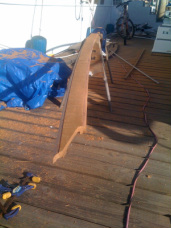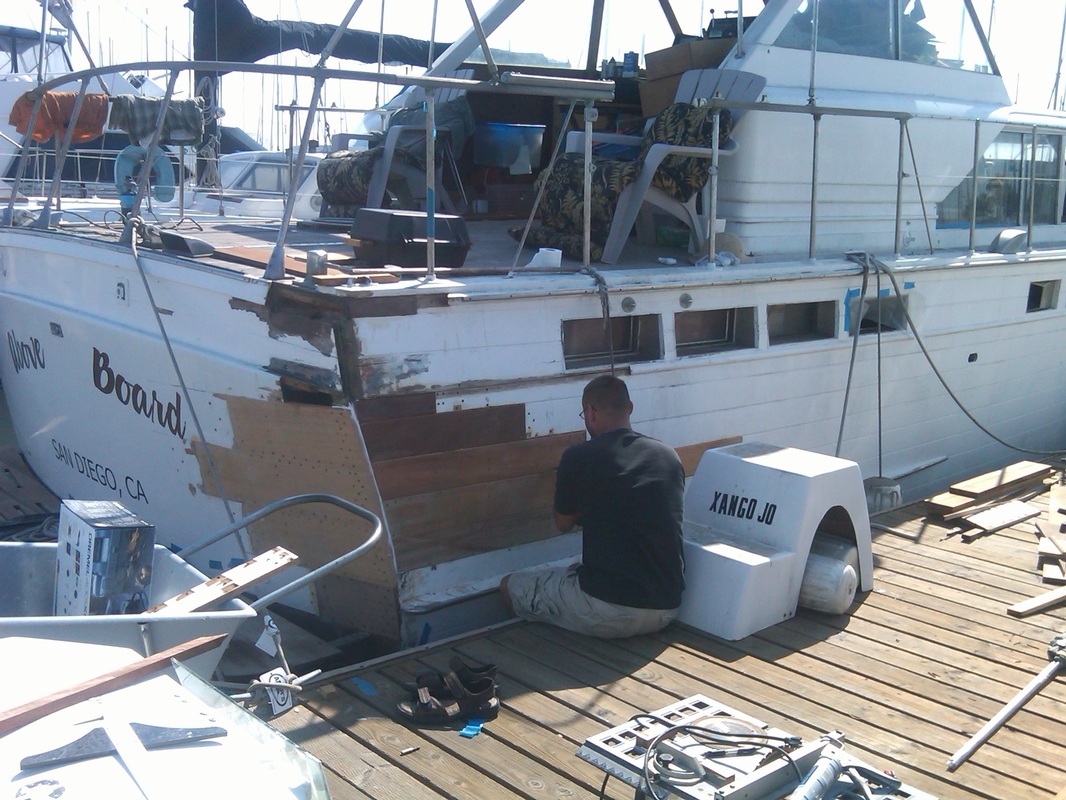The Craft of Wooden Boats: by Timothy P. Holmberg

A teak rail taking shape
Many people have asked me, "why a wooden boat? Don't they require a lot of work?" The question has evoked a number of answers from me (depending on my mood). But it's a fair question when there are so many alternatives. For me, there has always been a poetry and grace to wooden boats. They cannot help but show the skill of the hand that made them. The lines of classic yachts achieve a beautiful balance between form and function that no mould could ever replicate.
There is something about wood that has always inspired craftsmen. It's a unique, natural material - it is nature's composite. And unlike the man made fiberglass alternatives, wood was made by nature to be 100% recyclable - green before there was 'green'. Tucked into each wood fiber is the history of that tree, and the land on which it grew. The boats that were created from trees were made by hand, by craftsmen who loved their craft. When the mahogany planks of my boat were being assembled in 1965 at a boat yard in Algonac, Michigan, fiberglass was just emerging onto the stage. Most of the crafters then knew that in those glassy mats lay the obituary of their careers. They poured every bit of quality they could muster into the boats they built to forestall the fiberglass age. But time does march on. It's a process that has been termed 'creative destruction'. New technology displaces the old, and in the process, ideas and creative solutions die with the old technology. The restoration of this boat has shown me the value of some of those ideas from the past. In a very real sense, the boat is a floating time capsule. Some of what I have found has inspired me, and instigated new ideas - I call this 'creative reincarnation'.
Ultimately, a wooden boat does require more care than its plastic counterparts. But perhaps that is the very thing that our country has lost over the years. Our ability to care for the things we prize has been atrophied by the convenience of a disposable society. I have walked by many fiberglass boats (we call them Tupperware), and seen the white cloud that billows in the water when they are washed down. The white gel coat sloughing off into the water with God only knows what pollutants. Somewhere, in that cloud, I know is the proof that every convenience has its price. It is this drive for convenience and an aversion to hard work that has given rise to a division between the thinkers and the doers. Between the crafters and the engineers. "Don't work with your back, work with your mind." We are to be a nation of creators, who have never created anything with our own hands. But I know that if we stop making things with our own hands and yield to the new 'idea' economy, we will lose a vital connection. I know for myself that there is nothing I can create on a back-lit LED screen that will ever give me the satisfaction I get from working in wood and truly creating. Perhaps it is in preserving the evidence of what we can create ourselves, that the Compass Rose will realize her greatest value.
There is something about wood that has always inspired craftsmen. It's a unique, natural material - it is nature's composite. And unlike the man made fiberglass alternatives, wood was made by nature to be 100% recyclable - green before there was 'green'. Tucked into each wood fiber is the history of that tree, and the land on which it grew. The boats that were created from trees were made by hand, by craftsmen who loved their craft. When the mahogany planks of my boat were being assembled in 1965 at a boat yard in Algonac, Michigan, fiberglass was just emerging onto the stage. Most of the crafters then knew that in those glassy mats lay the obituary of their careers. They poured every bit of quality they could muster into the boats they built to forestall the fiberglass age. But time does march on. It's a process that has been termed 'creative destruction'. New technology displaces the old, and in the process, ideas and creative solutions die with the old technology. The restoration of this boat has shown me the value of some of those ideas from the past. In a very real sense, the boat is a floating time capsule. Some of what I have found has inspired me, and instigated new ideas - I call this 'creative reincarnation'.
Ultimately, a wooden boat does require more care than its plastic counterparts. But perhaps that is the very thing that our country has lost over the years. Our ability to care for the things we prize has been atrophied by the convenience of a disposable society. I have walked by many fiberglass boats (we call them Tupperware), and seen the white cloud that billows in the water when they are washed down. The white gel coat sloughing off into the water with God only knows what pollutants. Somewhere, in that cloud, I know is the proof that every convenience has its price. It is this drive for convenience and an aversion to hard work that has given rise to a division between the thinkers and the doers. Between the crafters and the engineers. "Don't work with your back, work with your mind." We are to be a nation of creators, who have never created anything with our own hands. But I know that if we stop making things with our own hands and yield to the new 'idea' economy, we will lose a vital connection. I know for myself that there is nothing I can create on a back-lit LED screen that will ever give me the satisfaction I get from working in wood and truly creating. Perhaps it is in preserving the evidence of what we can create ourselves, that the Compass Rose will realize her greatest value.





